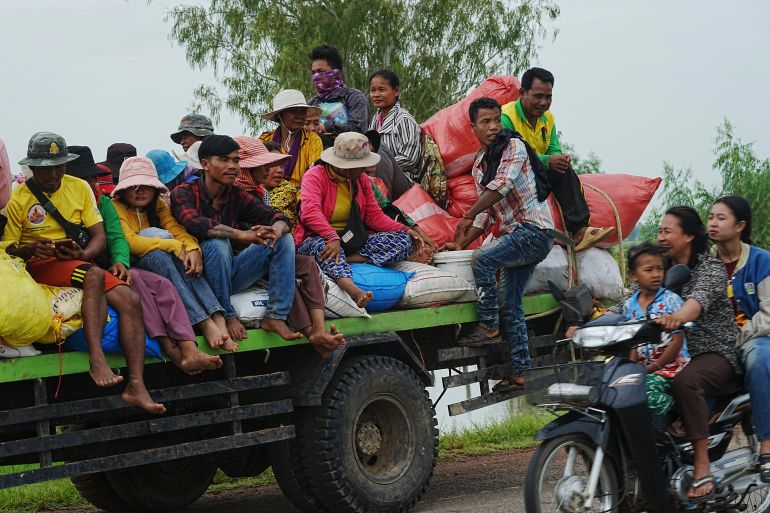In a bid to put an end to their most deadly border conflict in more than a decade, the leaders of Cambodia and Thailand have reached an “unconditional” ceasefire that will take effect on Monday at midnight.
After five days of bloody fighting that claimed at least 36 lives, Thailand’s acting prime minister Phumtham Wechayachai and Cambodia’s prime minister Hun Manet reaffirmed their resolve to put down their weapons.
Thailand and Cambodia have agreed to an “immediate and unconditional” ceasefire, according to Malaysian Prime Minister Anwar Ibrahim, who led the discussions in Putrajaya, the country’s administrative capital.
Anwar remarked, “This is a crucial first step toward de-escalation and the restoration of peace and security.” On Tuesday, he added, a meeting between the military chiefs of both countries will take place.
As Monday transitions to Tuesday at midnight (17:00 GMT), the ceasefire will become effective.
The border conflict that broke out on July 24 in Thailand and Cambodia has been blamed on one another. More than 270, 000 people from both sides of the 817-kilometer (508-mile) land border between Thailand and Cambodia have been displaced by the most recent conflict, which dates back to colonial-era maps.
What were the leaders’ rivals saying?
Hun Manet, the prime minister of Cambodia, stated: “Today we have a very good meeting and very good results… that hope to put an end to the fighting that has claimed many lives, injuries, and also caused displacement of people.
We hope that the solutions that Prime Minister Anwar just announced will provide a prerequisite for our bilateral discussion to resume normalcy and serve as a foundation for a de-escalation of forces in the future, he continued.
Thailand’s acting prime minister Phumtham Wechayachai, who had doubts about Cambodia’s sincerity ahead of the talks in Malaysia, said the two countries had agreed to a ceasefire that would “be carried out successfully in good faith by both sides.”
Malaysia, Thailand, and Cambodia said their respective defense ministers were instructed to create a detailed mechanism for the implementation, verification, and reporting of the ceasefire in a joint statement released after the talks had finished.
The parties also agreed to hold a meeting of their so-called “General Border Committee” in Cambodia on August 4.
What caused the two nations to fight?
Last week, the Southeast Asian neighbors accused one another of starting hostilities, before intensifying the conflict with heavy artillery bombardments.
Following weeks of growing tensions, which had been brewing since May when a Cambodian soldier was killed in an armed conflict along the border, fighting broke out on July 24 between the South Asian neighbors.
When Thai police prevented Cambodian tourists from singing their national anthem close to the holy site in February, a dispute erupted over Prasat Ta Moan Thom, a Khmer temple close to the Thai border.
More than 138, 000 people have been evacuated from areas near Cambodia, according to Thailand’s Interior Ministry since the start of the year. More than 20 000 Cambodians have been evacuated on the other side, according to local media.
According to Al Jazeera’s Tony Cheng, who was reporting from Surin, Thailand’s border province, the ceasefire announcement is good news for many people, especially those who live along the border and have been displaced.
He said on Monday, “There are so many people who have been affected by this, and they just want to go home so badly.”
Cheng also claimed that clashes were still occurring on both sides of the border even as the Malaysian talks were over.

What part did China and the US play?
At the meeting in Malaysia, American and Chinese diplomats also attended.
Cambodia’s prime minister Hun Manet claimed on Monday that the meeting had been “co-organized by the United States and with participation of China.”
Thailand and Cambodia are close political allies of China, and it has strong economic ties to both.
Marco Rubio, the US’s top foreign minister, welcomed the ceasefire on Monday. Rubio praised the Cambodian and Thailand’s declaration of a ceasefire in a statement released in Kuala Lumpur.
We ask that all parties fulfill their obligations.
Trump had threatened to stop trade negotiations with either country as long as fighting continued in separate calls with Phumtham and Hun Manet on Saturday.
Trump stated on Sunday, “We won’t agree to a trade agreement until you can resolve the war,” adding that both leaders indicated they were ready to bargain with him directly.
From August 1 through August 1, the US will likely impose a 36 percent tariff on both Thailand and Cambodia.
Source: Aljazeera

Leave a Reply